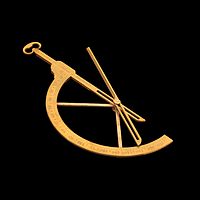
Photo from wikipedia
Traditional methods of measuring a joint angle are neither repeatable nor accurate and cannot instantly display, record, and upload the data onto a cloud drive. These mechanisms require development if… Click to show full abstract
Traditional methods of measuring a joint angle are neither repeatable nor accurate and cannot instantly display, record, and upload the data onto a cloud drive. These mechanisms require development if they are to be used to evaluate rehabilitation programs. This pilot study aim is to create a simple dynamic joint angle measurement system and develop a hand rehabilitation application for stroke users using small and sensitive 3-axis accelerometers. Using Bluetooth communication technology, an electrogoniometer is developed to measure the free range of motion of lower limb joints and automatically send and save all data on to a cloud drive. The reliability of the proposed device is evaluated by comparison with a commercial electrogoniometer. Five healthy youth subjects and five health elderly subjects are involved in the evaluation process for this pilot study. The accuracy and repeatability of the proposed device are tested using Bland–Altman plots and linear correlation analysis. Measurements that were made by the proposed device and a commercial electrogoniometer are shown to be comparable and repeatable, as confirmed by Bland–Atman plots. There is also a very high degree of linear correlation (R2 > 0.99 for all joint angle measurements) between the lower limb joint angles that are measured using both devices. In conclusion, a portable, highly accurate and repeatable device was designed to be used for clinical assessment and for rehabilitation application that gives increased motivation to the user.
Journal Title: Journal of Healthcare Engineering
Year Published: 2021
Link to full text (if available)
Share on Social Media: Sign Up to like & get
recommendations!